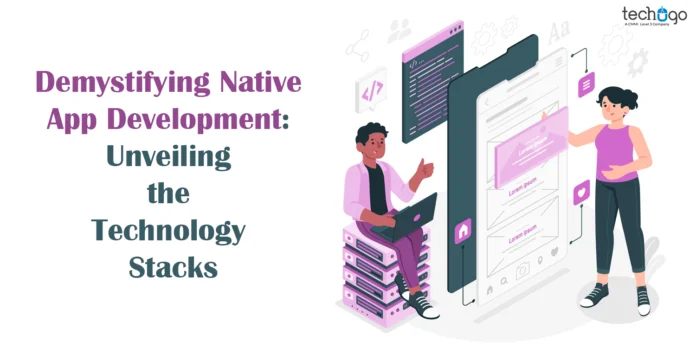In the vibrant landscape of mobile app development, our commitment to crafting exceptional native apps is underscored by the meticulous selection of cutting-edge technology stacks tailored for platforms like iOS and Android. Our native app development process is driven by a keen focus on efficiency, performance, and user experience. When you partner with the leading mobile app development company in UAE, a seamless fusion of expertise and innovation will come closer to your business process, guaranteeing that your app stands out with a personalized touch and an unparalleled user journey.
What are Native Apps?
At their core, native apps are software applications custom-tailored for a particular operating system (OS). Unlike cross-platform counterparts, which aim for universal compatibility, native apps are dedicated exclusively to platforms like iOS, Android, or Windows. This exclusivity ensures optimal performance and seamless integration with the distinctive features of each platform.
Characteristics that Set Native Apps Apart:
- Performance Prowess:
Native apps exhibit unparalleled speed and responsiveness, explicitly optimized for the underlying OS. They directly tap into the device’s capabilities, providing users a fluid and snappy experience.
- User Interface Harmony:
Crafted with adherence to platform-specific design guidelines, native apps seamlessly blend with the user interface (UI) of the device. This commitment to design principles fosters a familiar and intuitive interaction and increases user satisfaction.
- Access to Device Features:
Leveraging the full spectrum of device features, native apps integrate functionalities ranging from cameras and GPS to sensors and gestures. This direct access empowers developers to create experiences tightly woven into the device’s capabilities.
- Offline Functionality:
Many native apps can operate seamlessly without an internet connection, ensuring users have uninterrupted access to certain features or content, even offline.
Crafting a Native App: The Art and Science:
The development journey of a native app is a fusion of art and science.Usually, the developers engage with platform-specific languages, such as Swift for iOS or Kotlin for Android, moulding code to fit the intricate architecture of each operating system.
- iOS Native App Development:
Apple’s modern programming language, Swift, takes centre stage in crafting native iOS apps. The developers use Swift’s syntax to create apps seamlessly integrating with the iOS ecosystem.
- Android Native App Development:
Kotlin, known for its conciseness and interoperability with Java, is the language of choice for native Android app development. Developers leverage Kotlin to tap into the expansive Android API, creating apps that resonate with Android users.
Native Apps vs. Cross-Platform Solutions:
Native apps deliver unparalleled performance and a customized user experience, while cross-platform alternatives like React Native and Flutter offer the advantage of code reusability across multiple platforms.
Popular Tech Stacks used for Native apps creation:
As the top mobile app development company in Dubai, this blog will guide you through this decision-making process, ensuring their apps align seamlessly with their goals and user expectations. Let’s unravel the layers of technology stacks commonly employed in native app development.
- iOS Native App Stack:
– Language: Swift or Objective-C
– IDE: Xcode
– UI Framework: UIKit
– Version Control: Git
– Database: Core Data or Realm
– Networking: URLSession or Alamofire
Developers diving into iOS native app development wield Swift or Objective-C as their programming languages within the confines of Xcode. The UIKit framework provides a robust foundation for crafting engaging user interfaces, while Git ensures seamless version control. Core Data and Realm are preferred choices for managing app data, and networking tasks are efficiently handled using URLSession or Alamofire.
- Android Native App Stack:
– Language: Kotlin or Java
– IDE: Android Studio
– UI Framework: Android SDK
– Version Control: Git
– Database: Room or SQLite
– Networking: Retrofit or Volley
On the Android front, developers harness the power of Kotlin or Java within Android Studio. The Android SDK is the toolkit for building intuitive user interfaces, Git maintains version control, and Room or SQLite handles the app’s database needs. Networking functionalities find their prowess in libraries like Retrofit or Volley.
- Cross-Platform Native App Stack:
– Framework: React Native, Flutter, or Xamarin
– Language: JavaScript/TypeScript (React Native), Dart (Flutter), C# (Xamarin)
– IDE: Visual Studio Code or framework-specific IDEs
– UI Framework: Native components (mapped by the cross-platform framework)
– Version Control: Git
For those aiming at cross-platform development, frameworks like React Native, Flutter, or Xamarin come into play. Developers leverage JavaScript, TypeScript, Dart, or C# per the chosen framework. The development environment is often Visual Studio Code, and Git ensures effective version control.
- Backend Development (for Native Apps):
– Server-Side Language: Node.js, Python, Ruby, Java, etc.
– Server Framework: Express.js, Django, Ruby on Rails, Spring Boot, etc.
– Database: MongoDB, MySQL, PostgreSQL, etc.
– Authentication: OAuth, JWT
– Cloud Services: AWS, Firebase, Google Cloud
A robust backend is integral to native app functionality. Developers select server-side languages like Node.js, Python, or Ruby paired with frameworks like Express.js or Django. Databases such as MongoDB or MySQL store and retrieve data, and secure authentication is achieved through OAuth or JWT. Cloud services from AWS, Firebase, or Google Cloud provide scalable solutions.
- Additional Tools and Services:
– CI/CD: Jenkins, Travis CI, Bitrise
– Testing: XCTest (iOS), JUnit (Android), Detox, Appium
– Analytics: Firebase Analytics, Google Analytics, Flurry
– Crash Reporting: Firebase Crashlytics, Sentry
Additional tools and services come into play to ensure the reliability and performance of native apps. Continuous Integration/Continuous Deployment (CI/CD) tools like Jenkins or Bitrise facilitate smooth development workflows. Rigorous testing involves XCTest for iOS, JUnit for Android, and Detox and Appium for end-to-end testing. Analytics tools like Firebase Analytics and crash reporting tools like Firebase Crashlytics or Sentry enhance app performance monitoring.
In a Nutshell
Native app development demands a nuanced selection of technologies tailored to each platform’s requirements. The technology stacks outlined above exemplify the diverse tools and frameworks available to developers, empowering them to create seamless, performant, and user-friendly native apps. As the leading mobile app development company in UAE, staying attuned to the latest advancements in these technology stacks ensures users cutting-edge experiences.

